Laminae Characteristics and Their Relationship with Mudstone Reservoir Quality in the Qingshankou Formation, Sanzhao Depression, Songliao Basin, Northeast China
Abstract
:1. Introduction
2. Geological Setting
3. Samples and Methods
4. Results
4.1. Petrological Characteristics
4.1.1. Thick Siliceous Laminae
4.1.2. Thin Siliceous Laminae
4.1.3. Thin Siliceous and Argillaceous Mixed Laminae
4.2. Diagenetic Characteristics
4.2.1. Compaction
4.2.2. Cementation
4.2.3. Dissolution
4.2.4. Thermal Maturation of Organic Matter
4.3. Reservoir Pore Structure Characteristics
4.3.1. Thick Siliceous Laminae
4.3.2. Thin Siliceous Laminae
4.3.3. Thin Siliceous and Argillaceous Mixed Laminae
4.3.4. Quantitative Analysis of Porosity and Pore Size Distribution of Different Laminae
5. Discussion
5.1. Depositional Control of Laminae Types and Distribution
5.2. Diagenetic Control of Pore Development in Different Laminae
5.3. Integrated Depositional and Diagenetic Processes Control on Pore Characteristics in Different Laminae
6. Conclusions
Author Contributions
Funding
Data Availability Statement
Conflicts of Interest
References
- Jarvie, D.M.; Hill, R.J.; Ruble, T.E.; Pollastro, R.M. Unconventional Shale-Gas Systems: The Mississippian Barnett Shale of North-Central Texas as One Model for Thermogenic Shale-Gas Assessment. AAPG Bull. 2007, 91, 475–499. [Google Scholar] [CrossRef]
- Loucks, R.G.; Reed, R.M.; Ruppel, S.C.; Jarvie, D.M. Morphology, Genesis, and Distribution of Nanometer-Scale Pores in Siliceous Mudstones of the Mississippian Barnett Shale. J. Sediment. Res. 2009, 79, 848–861. [Google Scholar] [CrossRef]
- Aplin, A.C.; Macquaker, J.H.S. Mudstone Diversity: Origin and Implications for Source, Seal, and Reservoir Properties in Petroleum Systems. AAPG Bull. 2011, 95, 2031–2059. [Google Scholar] [CrossRef]
- Lazar, O.R.; Bohacs, K.M.; Macquaker, J.H.S.; Schieber, J.; Demko, T.M. Capturing Key Attributes of Fine-Grained Sedimentary Rocks in Outcrops, Cores, and Thin Sections: Nomenclature and Description Guidelines. J. Sediment. Res. 2015, 85, 230–246. [Google Scholar] [CrossRef]
- Du, F.; Huang, J.; Chai, Z.; Killough, J. Effect of Vertical Heterogeneity and Nano-Confinement on the Recovery Performance of Oil-Rich Shale Reservoir. Fuel 2020, 267, 117199. [Google Scholar] [CrossRef]
- Yin, Y.; Qu, Z.G.; Zhang, T.; Zhang, J.F.; Wang, Q.Q. Three-Dimensional Pore-Scale Study of Methane Gas Mass Diffusion in Shale with Spatially Heterogeneous and Anisotropic Features. Fuel 2020, 273, 117750. [Google Scholar] [CrossRef]
- Yuan, Y.; Rezaee, R.; Yu, H.; Zou, J.; Liu, K.; Zhang, Y. Compositional Controls on Nanopore Structure in Different Shale Lithofacies: A Comparison with Pure Clays and Isolated Kerogens. Fuel 2021, 303, 121079. [Google Scholar] [CrossRef]
- Chandra, D.; Vishal, V.; Bahadur, J.; Agrawal, A.K.; Das, A.; Hazra, B.; Sen, D. Nano-Scale Physicochemical Attributes and Their Impact on Pore Heterogeneity in Shale. Fuel 2022, 314, 123070. [Google Scholar] [CrossRef]
- Yu, H.; Fan, J.; Xia, J.; Liu, H.; Wu, H. Multiscale Gas Transport Behavior in Heterogeneous Shale Matrix Consisting of Organic and Inorganic Nanopores. J. Nat. Gas Sci. Eng. 2020, 75, 103139. [Google Scholar] [CrossRef]
- Venieri, M.; Mackie, S.J.; McKean, S.H.; Vragov, V.; Pedersen, P.K.; Eaton, D.W.; Galvis-Portilla, H.A.; Poirier, S. The Interplay between Cm- and m-Scale Geological and Geomechanical Heterogeneity in Organic-Rich Mudstones: Implications for Reservoir Characterization of Unconventional Shale Plays. J. Nat. Gas Sci. Eng. 2022, 97, 104363. [Google Scholar] [CrossRef]
- Dou, F.; Wang, J.G. A Numerical Investigation for the Impacts of Shale Matrix Heterogeneity on Hydraulic Fracturing with a Two-Dimensional Particle Assemblage Simulation Model. J. Nat. Gas Sci. Eng. 2022, 104, 104678. [Google Scholar] [CrossRef]
- Patel, R.; Zhang, Y.; Lin, C.-W.; Guerrero, J.; Deng, Y.; Pharr, G.M.; Xie, K.Y. Microstructural and Mechanical Property Characterization of Argillaceous, Kerogen-Rich, and Bituminous Shale Rocks. J. Nat. Gas Sci. Eng. 2022, 108, 104827. [Google Scholar] [CrossRef]
- Wang, G.; Jin, Z.; Liu, G.; Wang, R.; Zhao, G.; Tang, X.; Liu, K.; Zhang, Q. Pore System of the Multiple Lithofacies Reservoirs in Unconventional Lacustrine Shale Oil Formation. Int. J. Coal Geol. 2023, 273, 104270. [Google Scholar] [CrossRef]
- Wang, Y.; Yang, J. Origin of Organic Matter Pore Heterogeneity in Oil Mature Triassic Chang-7 Mudstones, Ordos Basin, China. Int. J. Coal Geol. 2024, 283, 104458. [Google Scholar] [CrossRef]
- Potter, P.E.; Maynard, J.B.; Depetris, P.J. Mud and Mudstones: Introduction and Overview; Springer Science & Business Media: Berlin/Heidelberg, Germany, 2005; ISBN 3-540-27082-5. [Google Scholar]
- O’Brien, N.R.; Slatt, R.M. Argillaceous Rock Atlas; Springer Science & Business Media: Berlin/Heidelberg, Germany, 2012; ISBN 1-4612-3422-0. [Google Scholar]
- Schieber, J. Significance of Styles of Epicontinental Shale Sedimentation in the Belt Basin, Mid-Proterozoic of Montana, U.S.A. Sediment. Geol. 1990, 69, 297–312. [Google Scholar] [CrossRef]
- Schieber, J. Distribution and Deposition of Mudstone Facies in the Upper Devonian Sonyea Group of New York. J. Sediment. Res. 1999, 69, 909–925. [Google Scholar] [CrossRef]
- Lei, Y.; Luo, X.; Wang, X.; Zhang, L.; Jiang, C.; Yang, W.; Yu, Y.; Cheng, M.; Zhang, L. Characteristics of Silty Laminae in Zhangjiatan Shale of Southeastern Ordos Basin, China: Implications for Shale Gas Formation. AAPG Bull. 2015, 99, 661–687. [Google Scholar] [CrossRef]
- Xin, B.; Zhao, X.; Hao, F.; Jin, F.; Pu, X.; Han, W.; Xu, Q.; Guo, P.; Tian, J. Laminae Characteristics of Lacustrine Shales from the Paleogene Kongdian Formation in the Cangdong Sag, Bohai Bay Basin, China: Why Do Laminated Shales Have Better Reservoir Physical Properties? Int. J. Coal Geol. 2022, 260, 104056. [Google Scholar] [CrossRef]
- Li, Z.; Schieber, J. Detailed Facies Analysis of the Upper Cretaceous Tununk Shale Member, Henry Mountains Region, Utah: Implications for Mudstone Depositional Models in Epicontinental Seas. Sediment. Geol. 2018, 364, 141–159. [Google Scholar] [CrossRef]
- Li, T.; Jiang, Z.; Su, P.; Zhang, X.; Chen, W.; Wang, X.; Ning, C.; Wang, Z.; Xue, Z. Effect of Laminae Development on Pore Structure in the Lower Third Member of the Shahejie Shale, Zhanhua Sag, Eastern China. Interpretation 2020, 8, T103–T114. [Google Scholar] [CrossRef]
- Liu, D.; Li, Z.; Jiang, Z.; Zhang, C.; Zhang, Z.; Wang, J.; Yang, D.; Song, Y.; Luo, Q. Impact of Laminae on Pore Structures of Lacustrine Shales in the Southern Songliao Basin, NE China. J. Asian Earth Sci. 2019, 182, 103935. [Google Scholar] [CrossRef]
- Gao, Z.; Duan, L.; Jiang, Z.; Huang, L.; Chang, J.; Zheng, G.; Wang, Z.; An, F.; Wei, W. Using Laser Scanning Confocal Microscopy Combined with Saturated Oil Experiment to Investigate the Pseudo In-Situ Occurrence Mechanism of Light and Heavy Components of Shale Oil in Sub-Micron Scale. J. Pet. Sci. Eng. 2023, 220, 111234. [Google Scholar] [CrossRef]
- Curtis, M.E.; Cardott, B.J.; Sondergeld, C.H.; Rai, C.S. Development of Organic Porosity in the Woodford Shale with Increasing Thermal Maturity. Int. J. Coal Geol. 2012, 103, 26–31. [Google Scholar] [CrossRef]
- Milliken, K.L.; Rudnicki, M.; Awwiller, D.N.; Zhang, T. Organic Matter-Hosted Pore System, Marcellus Formation (Devonian), Pennsylvania. AAPG Bull. 2013, 97, 177–200. [Google Scholar] [CrossRef]
- Pommer, M.; Milliken, K. Pore Types and Pore-Size Distributions across Thermal Maturity, Eagle Ford Formation, Southern Texas. AAPG Bull. 2015, 99, 1713–1744. [Google Scholar] [CrossRef]
- Tian, H.; Pan, L.; Xiao, X.; Wilkins, R.W.T.; Meng, Z.; Huang, B. A Preliminary Study on the Pore Characterization of Lower Silurian Black Shales in the Chuandong Thrust Fold Belt, Southwestern China Using Low Pressure N2 Adsorption and FE-SEM Methods. Mar. Pet. Geol. 2013, 48, 8–19. [Google Scholar] [CrossRef]
- Guo, S.; Mao, W. Division of Diagenesis and Pore Evolution of a Permian Shanxi Shale in the Ordos Basin, China. J. Pet. Sci. Eng. 2019, 182, 106351. [Google Scholar] [CrossRef]
- Liu, H.; Zhang, S.; Song, G.; Xuejun, W.; Teng, J.; Wang, M.; Bao, Y.; Yao, S.; Wang, W.; Zhang, S.; et al. Effect of Shale Diagenesis on Pores and Storage Capacity in the Paleogene Shahejie Formation, Dongying Depression, Bohai Bay Basin, East China. Mar. Pet. Geol. 2019, 103, 738–752. [Google Scholar] [CrossRef]
- Mastalerz, M.; Schimmelmann, A.; Drobniak, A.; Chen, Y. Porosity of Devonian and Mississippian New Albany Shale across a Maturation Gradient: Insights from Organic Petrology’, Gas Adsorption, and Mercury Intrusion. AAPG Bull. 2013, 97, 1621–1643. [Google Scholar] [CrossRef]
- Wang, Y.; Cheng, H.; Hu, Q.; Liu, L.; Hao, L. Diagenesis and Pore Evolution for Various Lithofacies of the Wufeng-Longmaxi Shale, Southern Sichuan Basin, China. Mar. Pet. Geol. 2021, 133, 105251. [Google Scholar] [CrossRef]
- Montgomery, C.T.; Smith, M.B. Hydraulic Fracturing: History of an Enduring Technology. J. Pet. Technol. 2010, 62, 26–40. [Google Scholar] [CrossRef]
- Figueiredo, B.; Tsang, C.-F.; Rutqvist, J.; Niemi, A. Study of Hydraulic Fracturing Processes in Shale Formations with Complex Geological Settings. J. Pet. Sci. Eng. 2017, 152, 361–374. [Google Scholar] [CrossRef]
- Hubbert, M.K.; Willis, D.G. Mechanics of Hydraulic Fracturing. Trans. AIME 1957, 210, 153–168. [Google Scholar] [CrossRef]
- Jamison, W.; Azad, A. The Hydraulic Fracture–Natural Fracture Network Configuration in Shale Reservoirs: Geological Limiting Factors. J. Pet. Sci. Eng. 2017, 159, 205–229. [Google Scholar] [CrossRef]
- Li, X.; Hofmann, H.; Yoshioka, K.; Luo, Y.; Liang, Y. Phase-Field Modelling of Interactions between Hydraulic Fractures and Natural Fractures. Rock Mech. Rock. Eng. 2022, 55, 6227–6247. [Google Scholar] [CrossRef]
- Heng, S.; Li, X.; Liu, X.; Chen, Y. Experimental Study on the Mechanical Properties of Bedding Planes in Shale. J. Nat. Gas Sci. Eng. 2020, 76, 103161. [Google Scholar] [CrossRef]
- Ougier-Simonin, A.; Renard, F.; Boehm, C.; Vidal-Gilbert, S. Microfracturing and Microporosity in Shales. Earth-Sci. Rev. 2016, 162, 198–226. [Google Scholar] [CrossRef]
- DeReuil, A.A.; Birgenheier, L.P.; McLennan, J. Effects of Anisotropy and Saturation on Geomechanical Behavior of Mudstone. J. Geophys. Res.-Solid Earth 2019, 124, 8101–8126. [Google Scholar] [CrossRef]
- Mokhtari, M.; Tutuncu, A.N. Impact of Laminations and Natural Fractures on Rock Failure in Brazilian Experiments: A Case Study on Green River and Niobrara Formations. J. Nat. Gas Sci. Eng. 2016, 36, 79–86. [Google Scholar] [CrossRef]
- O’Brien, N.R. Shale Lamination and Sedimentary Processes. Geol. Soc. Lond. Spec. Publ. 1996, 116, 23–36. [Google Scholar] [CrossRef]
- O’Brien, N.R. Significance of Lamination in Toarcian (Lower Jurassic) Shales from Yorkshire, Great Britain. Sediment. Geol. 1990, 67, 25–34. [Google Scholar] [CrossRef]
- Xin, B.; Hao, F.; Liu, X.; Han, W.; Xu, Q.; Guo, P.; Tian, J. Quantitative Evaluation of Pore Structures within Micron-Scale Laminae of Lacustrine Shales from the Second Member of the Kongdian Formation in Cangdong Sag, Bohai Bay Basin, China. Mar. Pet. Geol. 2022, 144, 105827. [Google Scholar] [CrossRef]
- Wang, C.; Zhang, B.; Hu, Q.; Shu, Z.; Sun, M.; Bao, H. Laminae Characteristics and Influence on Shale Gas Reservoir Quality of Lower Silurian Longmaxi Formation in the Jiaoshiba Area of the Sichuan Basin, China. Mar. Pet. Geol. 2019, 109, 839–851. [Google Scholar] [CrossRef]
- Shi, J.; Jin, Z.; Liu, Q.; Zhang, T.; Fan, T.; Gao, Z. Laminar Characteristics of Lacustrine Organic-Rich Shales and Their Significance for Shale Reservoir Formation: A Case Study of the Paleogene Shales in the Dongying Sag, Bohai Bay Basin, China. J. Asian Earth Sci. 2022, 223, 104976. [Google Scholar] [CrossRef]
- Anovitz, L.M.; Cole, D.R. Characterization and Analysis of Porosity and Pore Structures. Rev. Mineral. Geochem. 2015, 80, 61–164. [Google Scholar] [CrossRef]
- Ma, L.; Fauchille, A.-L.; Dowey, P.J.; Figueroa Pilz, F.; Courtois, L.; Taylor, K.G.; Lee, P.D. Correlative Multi-Scale Imaging of Shales: A Review and Future Perspectives. Geol. Soc. Lond. Spec. Publ. 2017, 454, 175–199. [Google Scholar] [CrossRef]
- Liu, B.; Wang, H.; Fu, X.; Bai, Y.; Bai, L.; Jia, M.; He, B. Lithofacies and Depositional Setting of a Highly Prospective Lacustrine Shale Oil Succession from the Upper Cretaceous Qingshankou Formation in the Gulong Sag, Northern Songliao Basin, Northeast China. AAPG Bull. 2019, 103, 405–432. [Google Scholar] [CrossRef]
- Wu, Z.; Littke, R.; Baniasad, A.; Yang, Z.; Tang, Z.; Grohmann, S. Geochemistry and Petrology of Petroleum Source Rocks in the Upper Cretaceous Qingshankou Formation, Songliao Basin, NE China. Int. J. Coal Geol. 2023, 270, 104222. [Google Scholar] [CrossRef]
- Sun, L.; Liu, H.; He, W.; Li, G.; Zhang, S.; Zhu, R.; Jin, X.; Meng, S.; Jiang, H. An analysis of major scientific problems and research paths of Gulong shale oil in Daqing Oilfield, NE China. Pet. Explor. Dev. 2021, 48, 527–540. [Google Scholar] [CrossRef]
- Angulo, S.; Buatois, L.A. Integrating Depositional Models, Ichnology, and Sequence Stratigraphy in Reservoir Characterization: The Middle Member of the Devonian–Carboniferous Bakken Formation of Subsurface Southeastern Saskatchewan Revisited. AAPG Bull. 2012, 96, 1017–1043. [Google Scholar] [CrossRef]
- Ramiro-Ramirez, S.; Bhandari, A.R.; Reed, R.M.; Flemings, P.B. Permeability of Upper Wolfcamp Lithofacies in the Delaware Basin: The Role of Stratigraphic Heterogeneity in the Production of Unconventional Reservoirs. AAPG Bull. 2024, 108, 293–326. [Google Scholar] [CrossRef]
- Meyer, M.J.; Donovan, A.D.; Pope, M.C. Depositional Environment and Source Rock Quality of the Woodbine and Eagle Ford Groups, Southern East Texas (Brazos) Basin: An Integrated Geochemical, Sequence Stratigraphic, and Petrographic Approach. AAPG Bull. 2021, 105, 809–843. [Google Scholar] [CrossRef]
- Qiu, Z.; Tao, H.; Zou, C.; Wang, H.; Ji, H.; Zhou, S. Lithofacies and Organic Geochemistry of the Middle Permian Lucaogou Formation in the Jimusar Sag of the Junggar Basin, NW China. J. Pet. Sci. Eng. 2016, 140, 97–107. [Google Scholar] [CrossRef]
- Wang, F.; Chen, R.; Yu, W.; Tian, J.; Liang, X.; Tan, X.; Gong, L. Characteristics of Lacustrine Deepwater Fine-Grained Lithofacies and Source-Reservoir Combination of Tight Oil in the Triassic Chang 7 Member in Ordos Basin, China. J. Pet. Sci. Eng. 2021, 202, 108429. [Google Scholar] [CrossRef]
- Liang, C.; Jiang, Z.; Cao, Y.; Wu, J.; Wang, Y.; Hao, F. Sedimentary Characteristics and Origin of Lacustrine Organic-Rich Shales in the Salinized Eocene Dongying Depression. GSA Bull. 2018, 130, 154–174. [Google Scholar] [CrossRef]
- Wang, F.; Feng, Z.; Wang, X.; Zeng, H. Effect of Organic Matter, Thermal Maturity and Clay Minerals on Pore Formation and Evolution in the Gulong Shale, Songliao Basin, China. Geoenergy Sci. Eng. 2023, 223, 211507. [Google Scholar] [CrossRef]
- Yang, W.; Li, Y.; Gao, R. Formation and Evolution of Nonmarine Petroleum in Songliao Basin, China. AAPG Bull. 1985, 69, 1112–1122. [Google Scholar] [CrossRef]
- Feng, Z.; Jia, C.; Xie, X.; Zhang, S.; Feng, Z.-h.; Cross, T.A. Tectonostratigraphic Units and Stratigraphic Sequences of the Nonmarine Songliao Basin, Northeast China. Basin Res. 2010, 22, 79–95. [Google Scholar] [CrossRef]
- Jin, Z.; Liang, X.; Bai, Z. Exploration Breakthrough and Its Significance of Gulong Lacustrine Shale Oil in the Songliao Basin, Northeastern China. Energy Geosci. 2022, 3, 120–125. [Google Scholar] [CrossRef]
- Wang, P.-J.; Mattern, F.; Didenko, N.A.; Zhu, D.-F.; Singer, B.; Sun, X.-M. Tectonics and Cycle System of the Cretaceous Songliao Basin: An Inverted Active Continental Margin Basin. Earth-Sci. Rev. 2016, 159, 82–102. [Google Scholar] [CrossRef]
- Wang, C.; Scott, R.W.; Wan, X.; Graham, S.A.; Huang, Y.; Wang, P.; Wu, H.; Dean, W.E.; Zhang, L. Late Cretaceous Climate Changes Recorded in Eastern Asian Lacustrine Deposits and North American Epieric Sea Strata. Earth-Sci. Rev. 2013, 126, 275–299. [Google Scholar] [CrossRef]
- Campbell, C.V. Lamina, Laminaset, Bed and Bedset. Sedimentology 1967, 8, 7–26. [Google Scholar] [CrossRef]
- Ingram, R.L. Terminology for the Thickness of Stratification and Parting Units in Sedimentary Rocks. GSA Bull. 1954, 65, 937–938. [Google Scholar] [CrossRef]
- Potter, P.E.; Maynard, J.B.; Pryor, W.A. Sedimentology of Shale: Study Guide and Reference Source; Springer Science & Business Media: Berlin/Heidelberg, Germany, 2012; ISBN 1-4612-9981-0. [Google Scholar]
- Schieber, J. Common Themes in the Formation and Preservation of Intrinsic Porosity in Shales and Mudstones—Illustrated with Examples across the Phanerozoic. In Proceedings of the SPE Unconventional Gas Conference 2010, Pittsburgh, PA, USA, 23–25 February 2010; pp. 428–437. [Google Scholar] [CrossRef]
- Loucks, R.G.; Reed, R.M. Scanning-Electron-Microscope Petrographic Evidence for Distinguishing Organic-Matter Pores Associated with Depositional Organic Matter versus Migrated Organic Matter in Mudrocks. Gulf Coast Assoc. Geol. Soc. J. 2014, 3, 51–60. [Google Scholar]
- Schimmelmann, A.; Lange, C.B.; Schieber, J.; Francus, P.; Ojala, A.E.K.; Zolitschka, B. Varves in Marine Sediments: A Review. Earth-Sci. Rev. 2016, 159, 215–246. [Google Scholar] [CrossRef]
- Zolitschka, B.; Francus, P.; Ojala, A.E.K.; Schimmelmann, A. Varves in Lake Sediments—A Review. Quat. Sci. Rev. 2015, 117, 1–41. [Google Scholar] [CrossRef]
- Wu, H.; Zhang, S.; Jiang, G.; Hinnov, L.; Yang, T.; Li, H.; Wan, X.; Wang, C. Astrochronology of the Early Turonian-Early Campanian Terrestrial Succession in the Songliao Basin, Northeastern China and Its Implication for Long-Period Behavior of the Solar System. Paleogeogr. Paleoclimatol. Paleoecol. 2013, 385, 55–70. [Google Scholar] [CrossRef]
- Schieber, J. Mud Re-Distribution in Epicontinental Basins—Exploring Likely Processes. Mar. Pet. Geol. 2016, 71, 119–133. [Google Scholar] [CrossRef]
- Yawar, Z.; Schieber, J. On the Origin of Silt Laminae in Laminated Shales. Sediment. Geol. 2017, 360, 22–34. [Google Scholar] [CrossRef]
- Loucks, R.G.; Reed, R.M.; Ruppel, S.C.; Hammes, U. Spectrum of Pore Types and Networks in Mudrocks and a Descriptive Classification for Matrix-Related Mudrock Pores. AAPG Bull. 2012, 96, 1071–1098. [Google Scholar] [CrossRef]
- Aplin, A.C.; Yang, Y.; Hansen, S. Assessment of β the Compression Coefficient of Mudstones and Its Relationship with Detailed Lithology. Mar. Pet. Geol. 1995, 12, 955–963. [Google Scholar] [CrossRef]
- Mondol, N.H.; Bjørlykke, K.; Jahren, J. Experimental Compaction of Clays: Relationship between Permeability and Petrophysical Properties in Mudstones. Petrol. Geosci. 2008, 14, 319–337. [Google Scholar] [CrossRef]
- Yang, Y.; Aplin, A.C. Permeability and Petrophysical Properties of 30 Natural Mudstones. J. Geophys. Res.-Solid Earth 2007, 112, 2005JB004243. [Google Scholar] [CrossRef]
- Dutton, S.P. Calcite Cement in Permian Deep-Water Sandstones, Delaware Basin, West Texas: Origin, Distribution, and Effect on Reservoir Properties. AAPG Bull. 2008, 92, 765–787. [Google Scholar] [CrossRef]
- Morad, S.; Al-Ramadan, K.; Ketzer, J.M.; De Ros, L.F. The Impact of Diagenesis on the Heterogeneity of Sandstone Reservoirs: A Review of the Role of Depositional Facies and Sequence Stratigraphy. AAPG Bull. 2010, 94, 1267–1309. [Google Scholar] [CrossRef]
- Wang, J.; Cao, Y.; Liu, K.; Liu, J.; Xue, X.; Xu, Q. Pore Fluid Evolution, Distribution and Water-Rock Interactions of Carbonate Cements in Red-Bed Sandstone Reservoirs in the Dongying Depression, China. Mar. Pet. Geol. 2016, 72, 279–294. [Google Scholar] [CrossRef]
- Xi, K.; Cao, Y.; Liu, K.; Wu, S.; Yuan, G.; Zhu, R.; Zhou, Y.; Hellevang, H. Geochemical Constraints on the Origins of Calcite Cements and Their Impacts on Reservoir Heterogeneities: A Case Study on Tight Oil Sandstones of the Upper Triassic Yanchang Formation, Southwestern Ordos Basin, China. AAPG Bull. 2019, 103, 2447–2485. [Google Scholar] [CrossRef]
- Xie, D.; Yao, S.; Cao, J.; Hu, W.; Qin, Y. Origin of Calcite Cements and Their Impact on Reservoir Heterogeneity in the Triassic Yanchang Formation, Ordos Basin, China: A Combined Petrological and Geochemical Study. Mar. Pet. Geol. 2020, 117, 104376. [Google Scholar] [CrossRef]
- Xiong, D.; Azmy, K.; Blamey, N.J.F. Diagenesis and Origin of Calcite Cement in the Flemish Pass Basin Sandstone Reservoir (Upper Jurassic): Implications for Porosity Development. Mar. Pet. Geol. 2016, 70, 93–118. [Google Scholar] [CrossRef]
- Bevan, J.; Savage, D. The Effect of Organic Acids on the Dissolution of K-Feldspar under Conditions Relevant to Burial Diagenesis. Mineral. Mag. 1989, 53, 415–425. [Google Scholar] [CrossRef]
- Surdam, R.C.; Crossey, L.J.; Hagen, E.S.; Heasler, H.P. Organic-Inorganic Interactions and Sandstone Diagenesis. AAPG Bull. 1989, 73, 1–23. [Google Scholar] [CrossRef]
- Surdam, R.C.; Boese, S.W.; Crossey, L.J. The Chemistry of Secondary Porosity. Clastic Diagenesis 1984, 37, 127–149. [Google Scholar] [CrossRef]
- Raiswell, R. Pyrite Texture, Isotopic Composition and the Availability of Iron. Am. J. Sci. 1982, 282, 1244–1263. [Google Scholar] [CrossRef]
- Taylor, K.G.; Macquaker, J.H.S. Early Diagenetic Pyrite Morphology in a Mudstone-Dominated Succession: The Lower Jurassic Cleveland Ironstone Formation, Eastern England. Sediment. Geol. 2000, 131, 77–86. [Google Scholar] [CrossRef]
- Wang, Q.; Morse, J.W. Pyrite Formation under Conditions Approximating Those in Anoxic Sediments I. Pathway and Morphology. Mar. Chem. 1996, 52, 99–121. [Google Scholar] [CrossRef]
- Wang, P.; Huang, Y.; Wang, C.; Feng, Z.; Huang, Q. Pyrite Morphology in the First Member of the Late Cretaceous Qingshankou Formation, Songliao Basin, Northeast China. Paleogeogr. Paleoclimatol. Paleoecol. 2013, 385, 125–136. [Google Scholar] [CrossRef]
- Boles, J.R.; Franks, S.G. Clay Diagenesis in Wilcox Sandstones of Southwest Texas; Implications of Smectite Diagenesis on Sandstone Cementation. J. Sediment. Res. 1979, 49, 55–70. [Google Scholar] [CrossRef]
- Hower, J.; Eslinger, E.V.; Hower, M.E.; Perry, E.A. Mechanism of Burial Metamorphism of Argillaceous Sediment: 1. Mineralogical and Chemical Evidence. GSA Bull. 1976, 87, 725–737. [Google Scholar] [CrossRef]
- Peltonen, C.; Marcussen, Ø.; Bjørlykke, K.; Jahren, J. Clay Mineral Diagenesis and Quartz Cementation in Mudstones: The Effects of Smectite to Illite Reaction on Rock Properties. Mar. Pet. Geol. 2009, 26, 887–898. [Google Scholar] [CrossRef]
- Thyberg, B.; Jahren, J.; Winje, T.; Bjørlykke, K.; Faleide, J.I.; Marcussen, Ø. Quartz Cementation in Late Cretaceous Mudstones, Northern North Sea: Changes in Rock Properties Due to Dissolution of Smectite and Precipitation of Micro-Quartz Crystals. Mar. Pet. Geol. 2010, 27, 1752–1764. [Google Scholar] [CrossRef]
- Liu, B.; Wang, Y.; Tian, S.; Guo, Y.; Wang, L.; Yasin, Q.; Yang, J. Impact of Thermal Maturity on the Diagenesis and Porosity of Lacustrine Oil-Prone Shales: Insights from Natural Shale Samples with Thermal Maturation in the Oil Generation Window. Int. J. Coal Geol. 2022, 261, 104079. [Google Scholar] [CrossRef]
- Aplin, A.C.; Matenaar, I.F.; McCarty, D.K.; van der Pluijm, B.A. Influence of Mechanical Compaction and Clay Mineral Diagenesis on the Microfabric and Pore-Scale Properties of Deep-Water Gulf of Mexico Mudstones. Clays Clay Min. 2006, 54, 500–514. [Google Scholar] [CrossRef]
- Day-Stirrat, R.J.; Aplin, A.C.; Środoń, J.; van der Pluijm, B.A. Diagenetic Reorientation of Phyllosilicate Minerals in Paleogene Mudstones of the Podhale Basin, Southern Poland. Clays Clay Min. 2008, 56, 100–111. [Google Scholar] [CrossRef]
- Ho, N.-C.; Peacor, D.R.; van der Pluijm, B.A. Preferred Orientation of Phyllosilicates in Gulf Coast Mudstones and Relation to the Smectite-Illite Transition. Clays Clay Min. 1999, 47, 495–504. [Google Scholar] [CrossRef]
- Vidal, O.; Dubacq, B. Thermodynamic Modelling of Clay Dehydration, Stability and Compositional Evolution with Temperature, Pressure and H2O Activity. Geochim. Cosmochim. Acta 2009, 73, 6544–6564. [Google Scholar] [CrossRef]
- Beaufort, D.; Rigault, C.; Billon, S.; Billault, V.; Inoue, A.; Inoue, S.; Patrier, P. Chlorite and Chloritization Processes through Mixed-Layer Mineral Series in Low-Temperature Geological Systems—A Review. Clay Min. 2015, 50, 497–523. [Google Scholar] [CrossRef]
- Chang, H.K. Comparisons between the Diagenesis of Dioctahedral and Trioctahedral Smectite, Brazilian Offshore Basins. Clays Clay Min. 1986, 34, 407–423. [Google Scholar] [CrossRef]
- Charlaftis, D.; Jones, S.J.; Dobson, K.J.; Crouch, J.; Acikalin, S. Experimental Study of Chlorite Authigenesis and Influence on Porosity Maintenance in Sandstones. J. Sediment. Res. 2021, 91, 197–212. [Google Scholar] [CrossRef]
- Worden, R.H.; Griffiths, J.; Wooldridge, L.J.; Utley, J.E.P.; Lawan, A.Y.; Muhammed, D.D.; Simon, N.; Armitage, P.J. Chlorite in Sandstones. Earth-Sci. Rev. 2020, 204, 103105. [Google Scholar] [CrossRef]
- Bernard, S.; Wirth, R.; Schreiber, A.; Schulz, H.M.; Horsfield, B. Formation of Nanoporous Pyrobitumen Residues during Maturation of the Barnett Shale (Fort Worth Basin). Int. J. Coal Geol. 2012, 103, 3–11. [Google Scholar] [CrossRef]
- Ko, L.T.; Ruppel, S.C.; Loucks, R.G.; Hackley, P.C.; Zhang, T.; Shao, D. Pore-Types and Pore-Network Evolution in Upper Devonian-Lower Mississippian Woodford and Mississippian Barnett Mudstones: Insights from Laboratory Thermal Maturation and Organic Petrology. Int. J. Coal Geol. 2018, 190, 3–28. [Google Scholar] [CrossRef]
- Liu, B.; Mastalerz, M.; Schieber, J. SEM Petrography of Dispersed Organic Matter in Black Shales: A Review. Earth-Sci. Rev. 2022, 224, 103874. [Google Scholar] [CrossRef]
- Wei, L.; Mastalerz, M.; Schimmelmann, A.; Chen, Y. Influence of Soxhlet-Extractable Bitumen and Oil on Porosity in Thermally Maturing Organic-Rich Shales. Int. J. Coal Geol. 2014, 132, 38–50. [Google Scholar] [CrossRef]
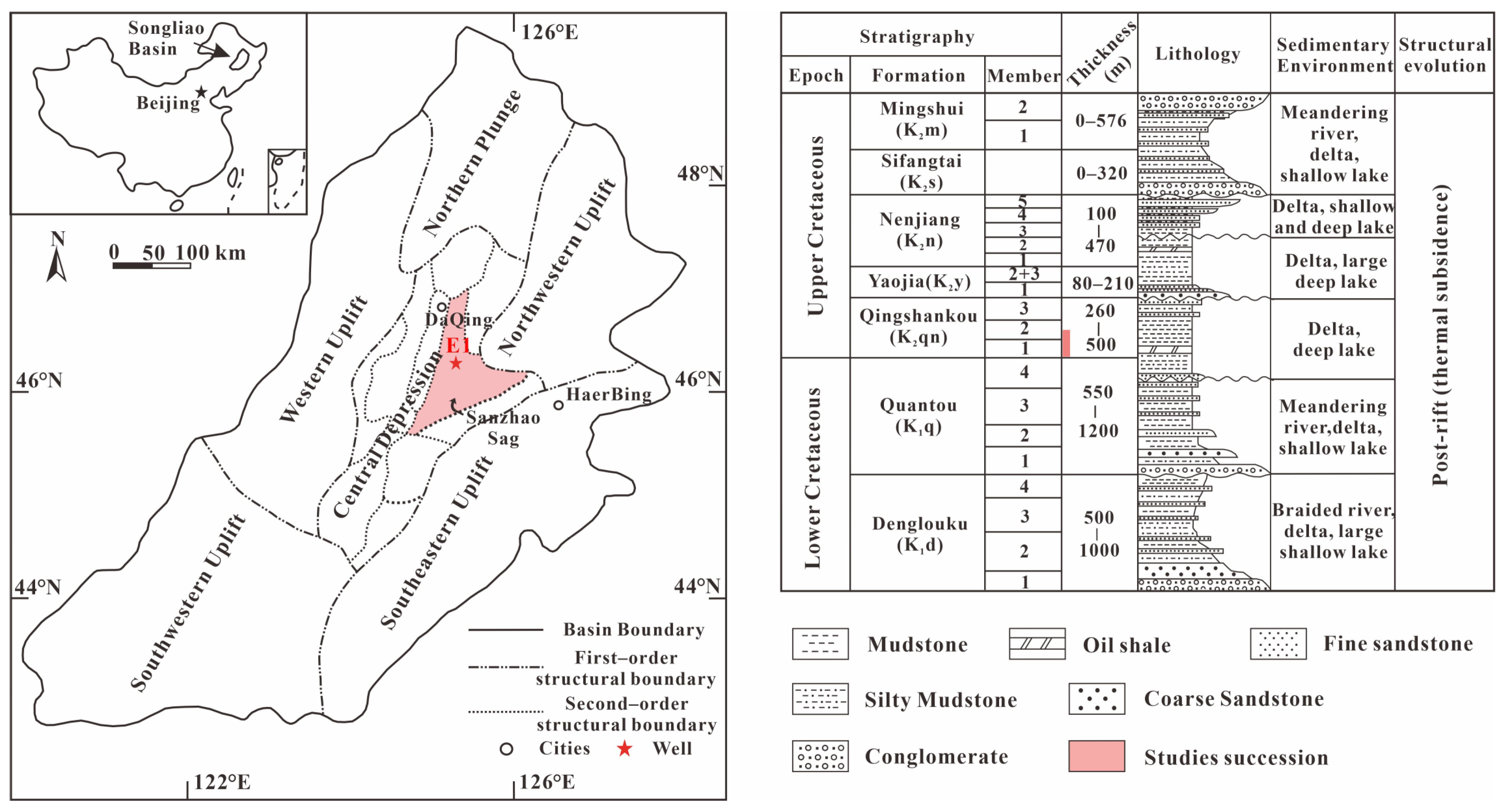

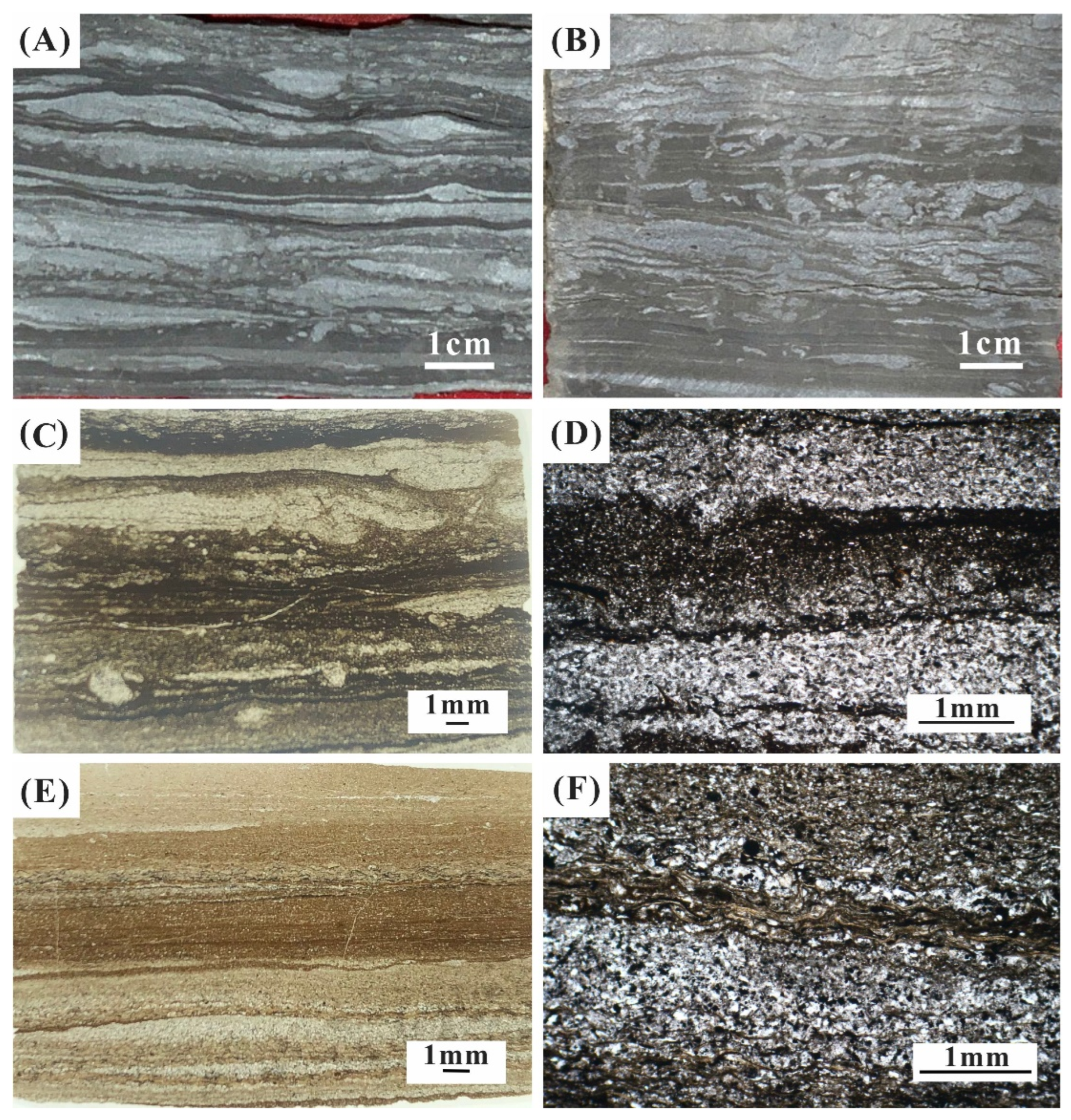
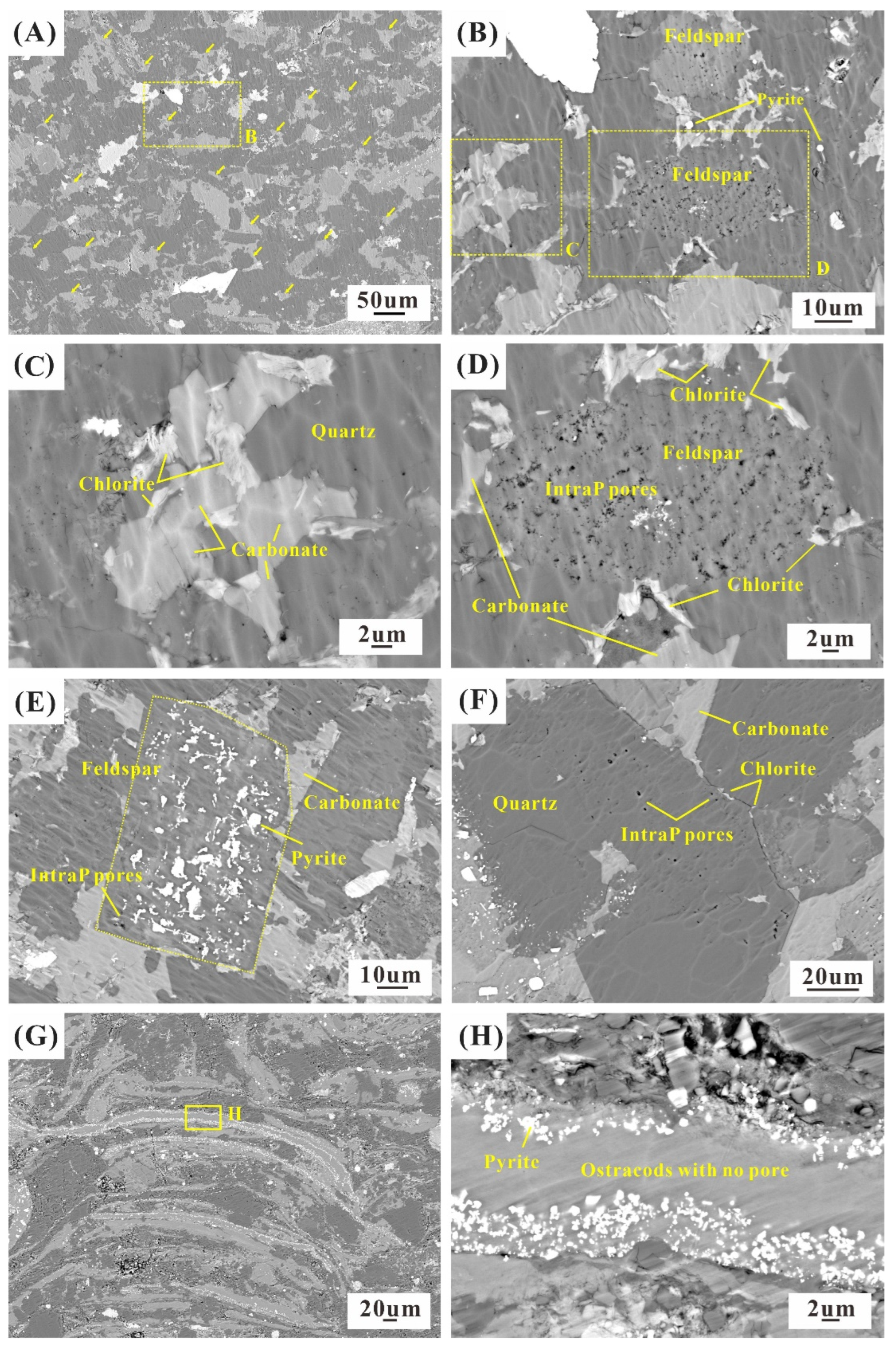
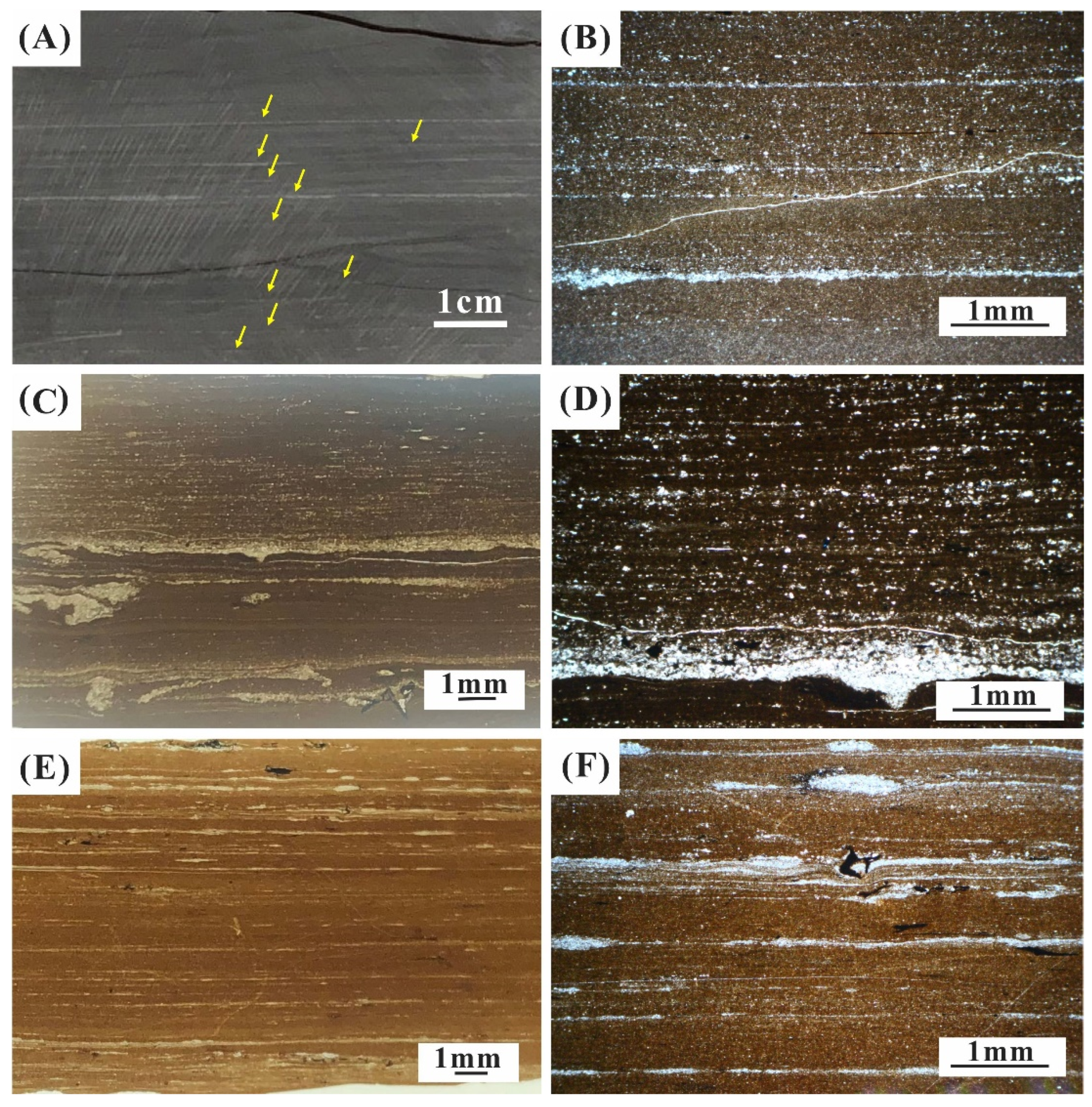
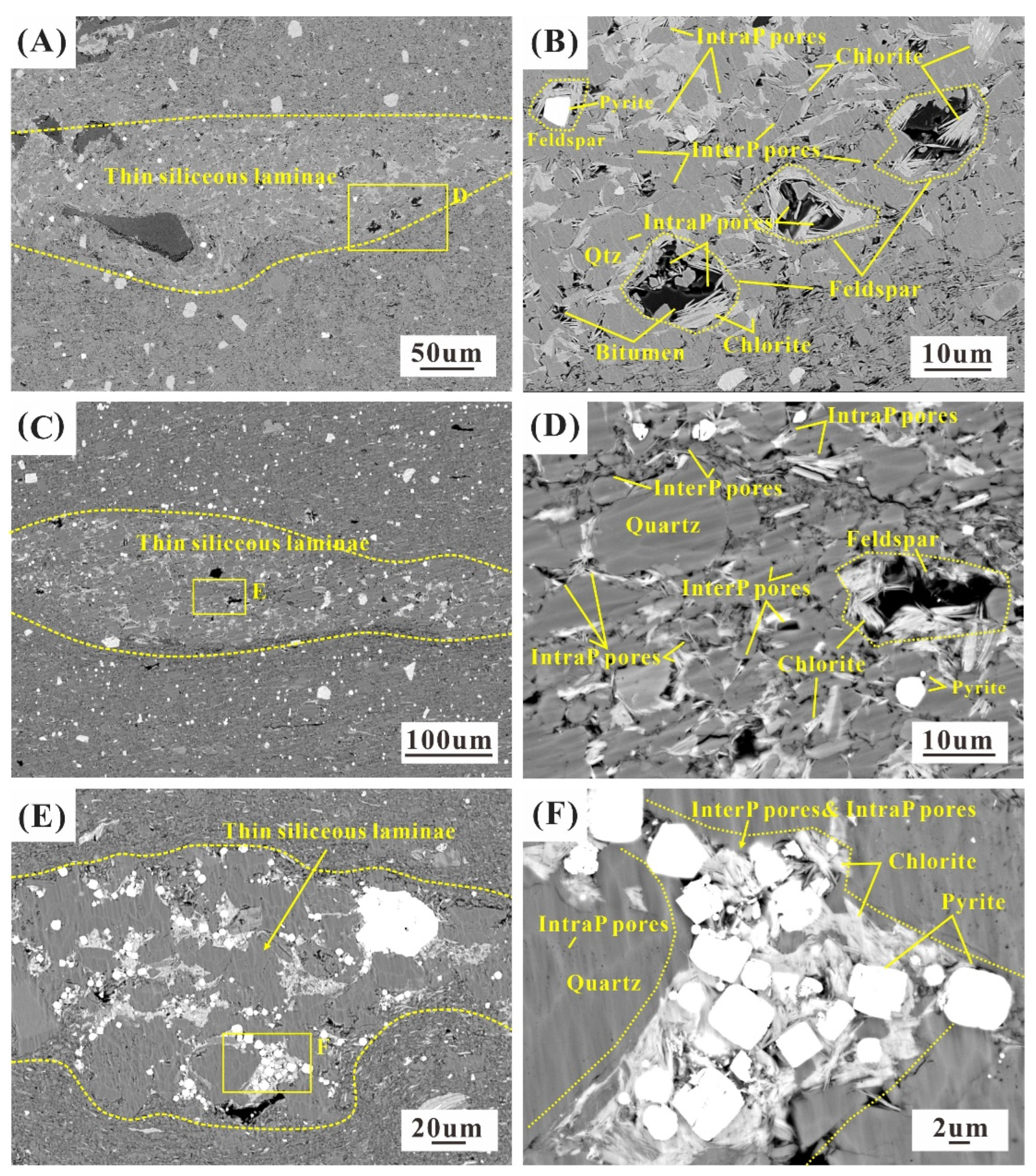
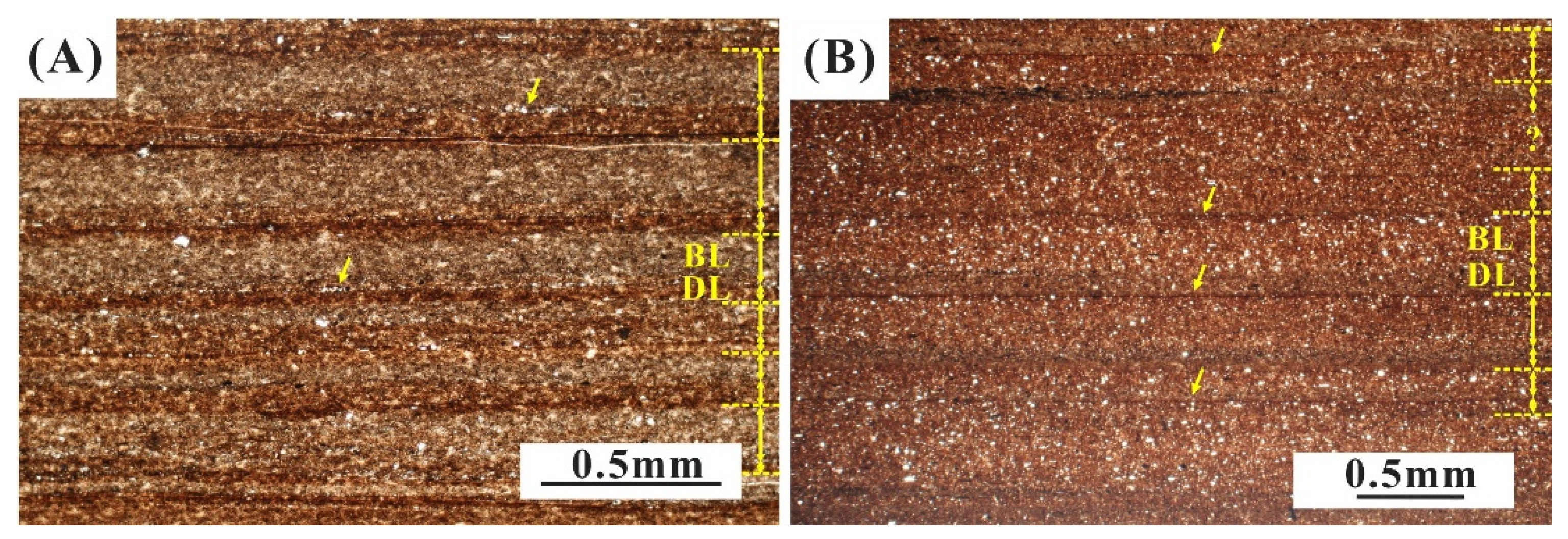
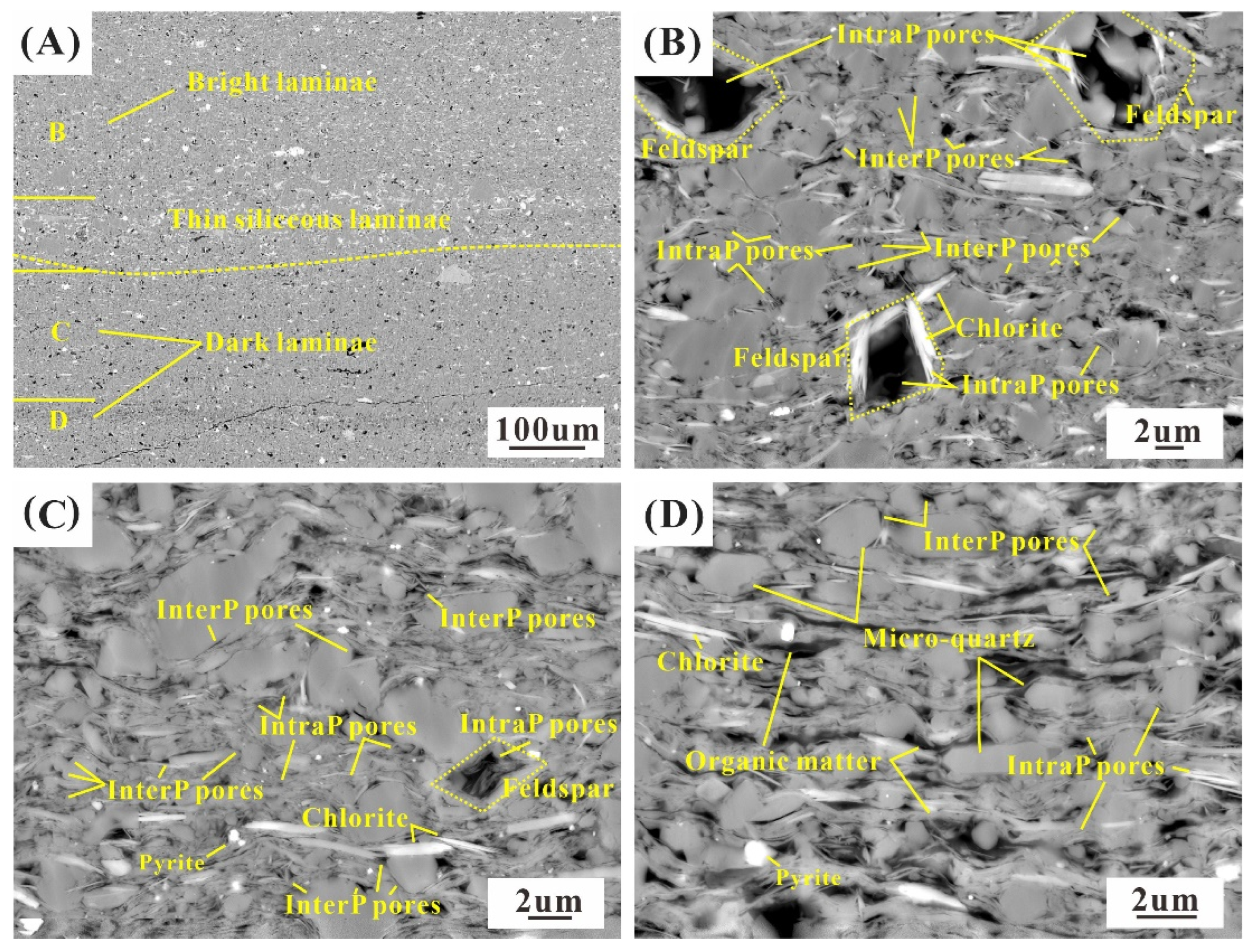
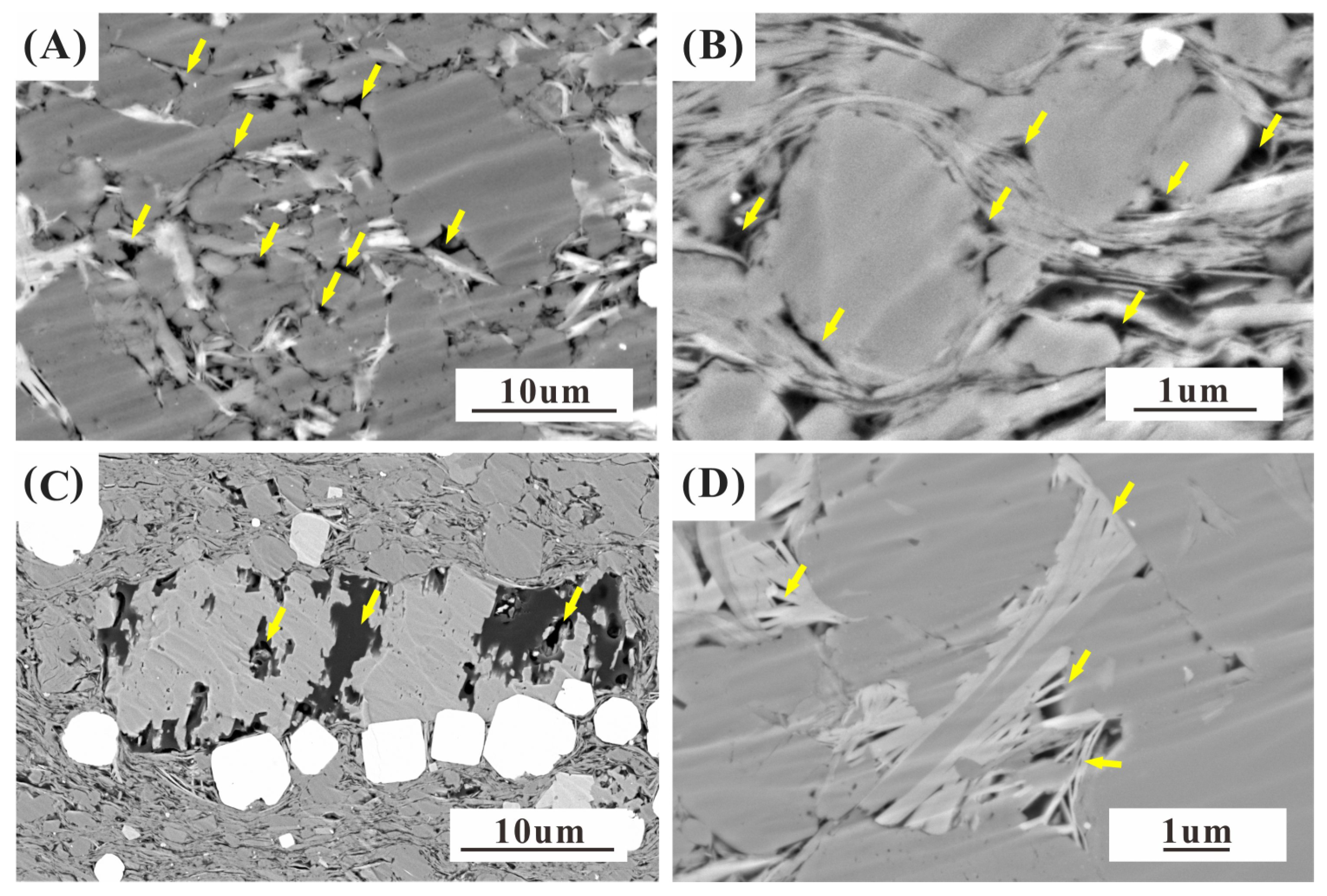
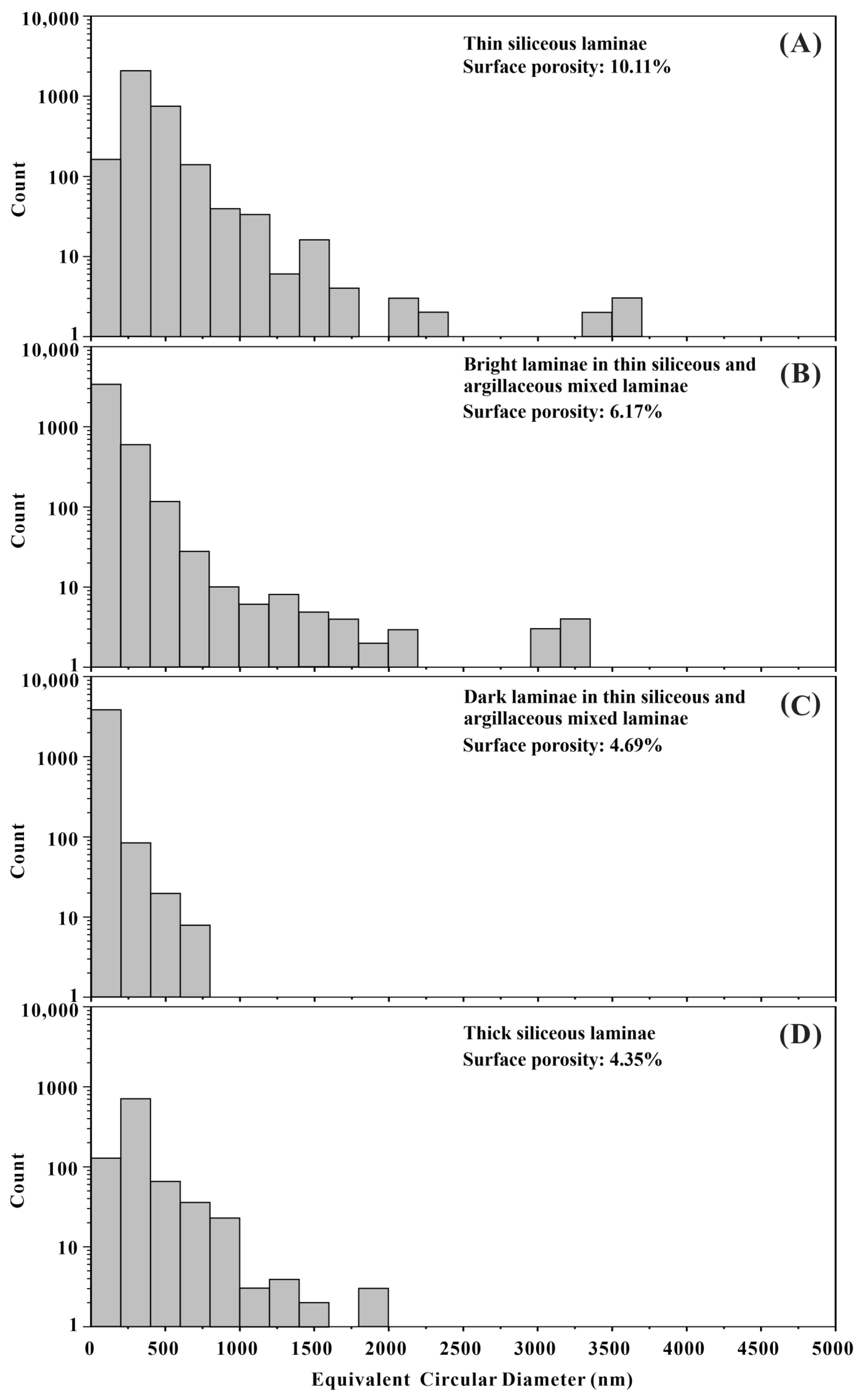
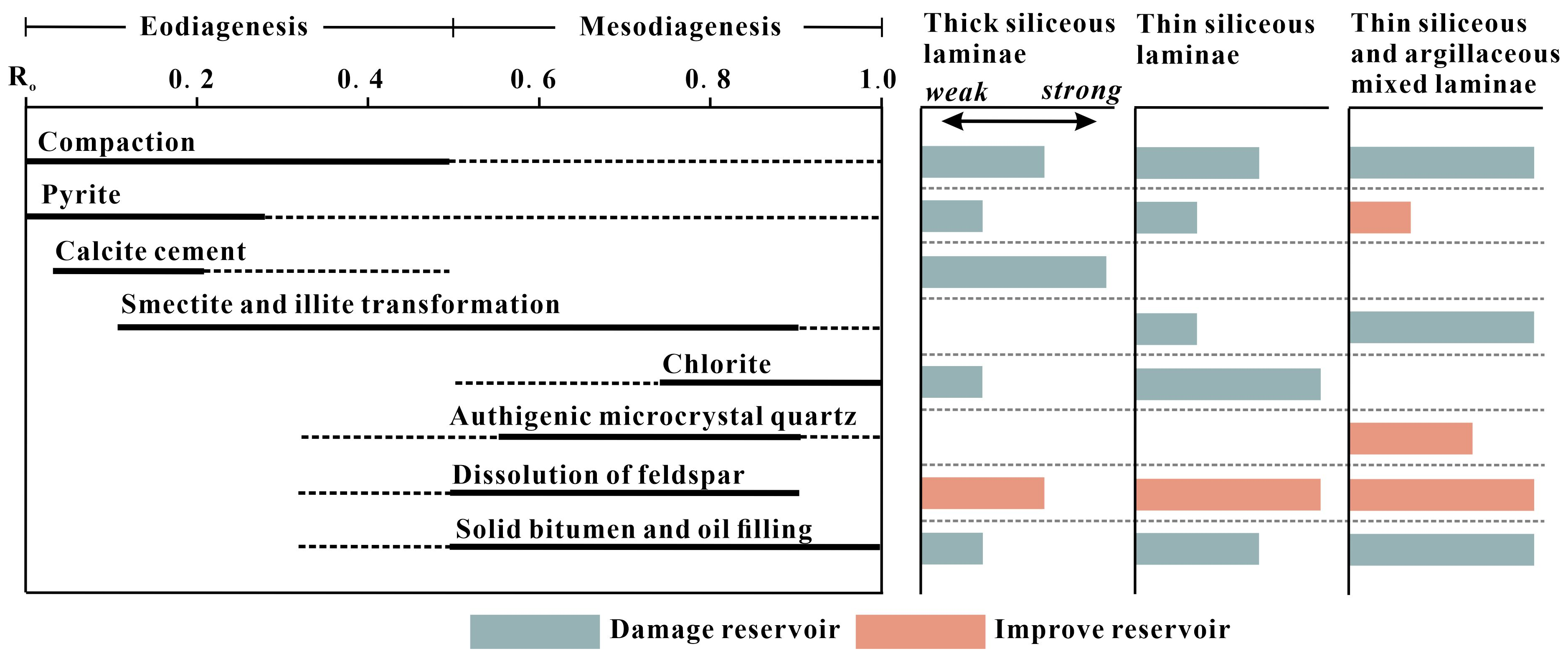

Disclaimer/Publisher’s Note: The statements, opinions and data contained in all publications are solely those of the individual author(s) and contributor(s) and not of MDPI and/or the editor(s). MDPI and/or the editor(s) disclaim responsibility for any injury to people or property resulting from any ideas, methods, instructions or products referred to in the content. |
© 2024 by the authors. Licensee MDPI, Basel, Switzerland. This article is an open access article distributed under the terms and conditions of the Creative Commons Attribution (CC BY) license (https://creativecommons.org/licenses/by/4.0/).
Share and Cite
Wu, H.; Xu, H.; Zhou, H.; Shang, F.; Wang, L.; Jiang, P.; Men, X.; Liu, D. Laminae Characteristics and Their Relationship with Mudstone Reservoir Quality in the Qingshankou Formation, Sanzhao Depression, Songliao Basin, Northeast China. Minerals 2024, 14, 600. https://doi.org/10.3390/min14060600
Wu H, Xu H, Zhou H, Shang F, Wang L, Jiang P, Men X, Liu D. Laminae Characteristics and Their Relationship with Mudstone Reservoir Quality in the Qingshankou Formation, Sanzhao Depression, Songliao Basin, Northeast China. Minerals. 2024; 14(6):600. https://doi.org/10.3390/min14060600
Chicago/Turabian StyleWu, Heng, Hao Xu, Haiyan Zhou, Fei Shang, Lan Wang, Pengfei Jiang, Xinyang Men, and Ding Liu. 2024. "Laminae Characteristics and Their Relationship with Mudstone Reservoir Quality in the Qingshankou Formation, Sanzhao Depression, Songliao Basin, Northeast China" Minerals 14, no. 6: 600. https://doi.org/10.3390/min14060600
APA StyleWu, H., Xu, H., Zhou, H., Shang, F., Wang, L., Jiang, P., Men, X., & Liu, D. (2024). Laminae Characteristics and Their Relationship with Mudstone Reservoir Quality in the Qingshankou Formation, Sanzhao Depression, Songliao Basin, Northeast China. Minerals, 14(6), 600. https://doi.org/10.3390/min14060600






